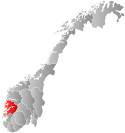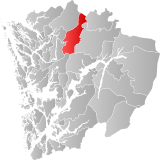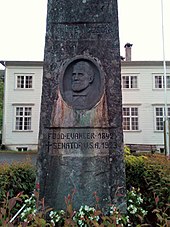Evanger
Evanger Municipality
Evanger herad | |
|---|---|
| Ævanger herred (historic name) | |
 View of Evanger village | |
 Hordaland within Norway | |
 Evanger within Hordaland | |
| Coordinates: 60°39′N 06°07′E / 60.650°N 6.117°E | |
| Country | Norway |
| County | Hordaland |
| District | Voss |
| Established | 1 Jan 1885 |
| • Preceded by | Voss Municipality |
| Disestablished | 1 Jan 1964 |
| • Succeeded by | Voss and Vaksdal municipalities |
| Administrative centre | Evanger |
| Government | |
| • Mayor (1948-1963) | Ivar Bjørgo (Sp) |
| Area (upon dissolution) | |
| • Total | 590 km2 (230 sq mi) |
| Population (1963) | |
| • Total | 1,326 |
| • Density | 2.2/km2 (5.8/sq mi) |
| Demonym | Vassvøring[1] |
| Time zone | UTC+01:00 (CET) |
| • Summer (DST) | UTC+02:00 (CEST) |
| ISO 3166 code | NO-1237[2] |
Evanger is a former municipality in the Voss district of the old Hordaland county in Norway. The municipality existed from 1885 until 1964 when it was dissolved and its lands split between two municipalities. The 590-square-kilometre (230 sq mi) municipality included the eastern part of the Eksingedalen valley, the area surrounding the lake Evangervatnet, and the Bergsdalen valley.[3]

The administrative centre of the municipality was the village of Evanger where Evanger Church is located. Evanger Church served the central part of the municipality. Nesheim Church and Eksingedal Church served the northern part of Evanger and Bergsdalen Church served the southern part of the municipality.
History
[edit]The municipality was established on 1 January 1885 when the western district of the large municipality of Voss (population: 2,045) was separated from Voss to become the new municipality of Evanger. During the 1960s, there were many municipal mergers across Norway due to the work of the Schei Committee. On 1 January 1964, the municipality of Evanger was dissolved. The Bergsdalen and Eksingedalen valleys (population: 251) were merged with parts of the municipalities of Bruvik and Modalen to create the new Vaksdal Municipality. The rest of Evanger, with 1,075 inhabitants, was merged into the neighboring Voss Municipality.[4]
Name
[edit]The municipality (originally the parish) is named after the old Evanger farm (Old Norse: Ævangir) since the first Evanger Church was built there. The first element comes from the word æja which means "to rest and eat" or "to rest and feed". The last element is the plural form of vangr which means "field" or "meadow". The name probably means something like "a place where one lets horses graze while on a journey". Historically, the name was spelled Ævanger until the early 20th century.[5]
Government
[edit]During its existence, this municipality was governed by a municipal council of directly elected representatives. The mayor was indirectly elected by a vote of the municipal council.[6]
Municipal council
[edit]The municipal council (Heradsstyre) of Evanger was made up of 17 representatives that were elected to four year terms. The party breakdown of the final municipal council was as follows:
| Party name (in Nynorsk) | Number of representatives | |
|---|---|---|
| Labour Party (Arbeidarpartiet) | 4 | |
| Conservative Party (Høgre) | 1 | |
| Centre Party (Senterpartiet) | 7 | |
| Liberal Party (Venstre) | 5 | |
| Total number of members: | 17 | |
| Party name (in Nynorsk) | Number of representatives | |
|---|---|---|
| Labour Party (Arbeidarpartiet) | 4 | |
| Conservative Party (Høgre) | 1 | |
| Farmers' Party (Bondepartiet) | 8 | |
| Liberal Party (Venstre) | 4 | |
| Total number of members: | 17 | |
| Party name (in Nynorsk) | Number of representatives | |
|---|---|---|
| Labour Party (Arbeidarpartiet) | 4 | |
| Farmers' Party (Bondepartiet) | 6 | |
| Joint List(s) of Non-Socialist Parties (Borgarlege Felleslister) | 6 | |
| Total number of members: | 16 | |
| Party name (in Nynorsk) | Number of representatives | |
|---|---|---|
| Labour Party (Arbeidarpartiet) | 4 | |
| Christian Democratic Party (Kristeleg Folkeparti) | 3 | |
| Farmers' Party (Bondepartiet) | 6 | |
| Liberal Party (Venstre) | 3 | |
| Total number of members: | 16 | |
| Party name (in Nynorsk) | Number of representatives | |
|---|---|---|
| Labour Party (Arbeidarpartiet) | 4 | |
| Farmers' Party (Bondepartiet) | 6 | |
| Liberal Party (Venstre) | 6 | |
| Total number of members: | 16 | |
| Party name (in Nynorsk) | Number of representatives | |
|---|---|---|
| Labour Party (Arbeidarpartiet) | 4 | |
| Local List(s) (Lokale lister) | 12 | |
| Total number of members: | 16 | |
| Note: Due to the German occupation of Norway during World War II, no elections were held for new municipal councils until after the war ended in 1945. | ||
Mayors
[edit]
The mayors (Nynorsk: ordførar) of Evanger:[13][14][15][16]
- 1885–1887: Gulleik Horvei
- 1888–1897: Anders Kvilekvaal
- 1898–1898: Johannes Horvei (V)
- 1899–1913: Nils B. Mugaas (V)
- 1914–1916: Johannes Horvei (V)
- 1917–1928: Nils B. Mugaas (V)
- 1929–1937: Olav B. Rongen (V)
- 1938–1941: Gustav A. Hantveit (V)
- 1942–1945: Lars B. Horvei (NS)
- 1945–1946: Gustav A. Hantveit (V)
- 1946–1947: Magne Hjørnevik (Bp)
- 1948–1963: Ivar Bjørgo (Bp)
Notable people
[edit]- Knute Nelson (1843–1923), a United States Senator
- Bjørn Rongen (1906–1983), a novelist and children's book writer
- Viking Mestad, a politician for the Norwegian Liberal Party
See also
[edit]References
[edit]- ^ "Navn på steder og personer: Innbyggjarnamn" (in Norwegian). Språkrådet.
- ^ Bolstad, Erik; Thorsnæs, Geir, eds. (26 January 2023). "Kommunenummer". Store norske leksikon (in Norwegian). Kunnskapsforlaget.
- ^ Store norske leksikon. "Evanger – tidl. kommune" (in Norwegian). Retrieved 10 May 2014.
- ^ Jukvam, Dag (1999). Historisk oversikt over endringer i kommune- og fylkesinndelingen (PDF) (in Norwegian). Statistisk sentralbyrå. ISBN 9788253746845.
- ^ Rygh, Oluf (1910). Norske gaardnavne: Søndre Bergenhus amt (in Norwegian) (11 ed.). Kristiania, Norge: W. C. Fabritius & sønners bogtrikkeri. p. 521.
- ^ Hansen, Tore; Vabo, Signy Irene, eds. (20 September 2022). "kommunestyre". Store norske leksikon (in Norwegian). Kunnskapsforlaget. Retrieved 1 January 2023.
- ^ "Kommunevalgene og Ordførervalgene 1959" (PDF) (in Norwegian). Oslo: Statistisk sentralbyrå. 1960. Retrieved 15 February 2020.
- ^ "Kommunevalgene og Ordførervalgene 1955" (PDF) (in Norwegian). Oslo: Statistisk sentralbyrå. 1957. Retrieved 16 February 2020.
- ^ "Kommunevalgene og Ordførervalgene 1951" (PDF) (in Norwegian). Oslo: Statistisk sentralbyrå. 1952. Retrieved 16 February 2020.
- ^ "Kommunevalgene og Ordførervalgene 1947" (PDF) (in Norwegian). Oslo: Statistisk sentralbyrå. 1948. Retrieved 16 February 2020.
- ^ "Kommunevalgene og Ordførervalgene 1945" (PDF) (in Norwegian). Oslo: Statistisk sentralbyrå. 1947. Retrieved 16 February 2020.
- ^ "Kommunevalgene og Ordførervalgene 1937" (PDF) (in Norwegian). Oslo: Statistisk sentralbyrå. 1938. Retrieved 16 May 2020.
- ^ Gjerdåker, Johannes (1991). Ålmenn soge for Voss: Frå 1800 til vår tid (in Norwegian). Vol. 2. Voss. p. 222. ISBN 8290622112.
{{cite book}}: CS1 maint: location missing publisher (link) - ^ Schjærven, Lars; Gjerdåker, Johannes (1982). Evangerboka. Gards- og ættesoge (in Norwegian). Vol. 1. Voss. ISBN 8271010875.
{{cite book}}: CS1 maint: location missing publisher (link) - ^ Schjærven, Lars; Gjerdåker, Johannes (1984). Evangerboka. Gards- og ættesoge (in Norwegian). Vol. 2. Voss. ISBN 8299122104.
{{cite book}}: CS1 maint: location missing publisher (link) - ^ Ringheim, Johannes; Leiro, Lars; Ringheim, Anders, eds. (1991). Voss senterparti 70 år. Politisk oversyn – bygdepolitikken 1921–1991 (in Norwegian). Voss. pp. 62–84. ISBN 8290451369.
{{cite book}}: CS1 maint: location missing publisher (link)
External links
[edit]

